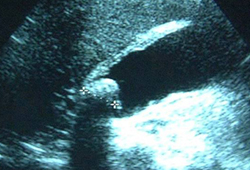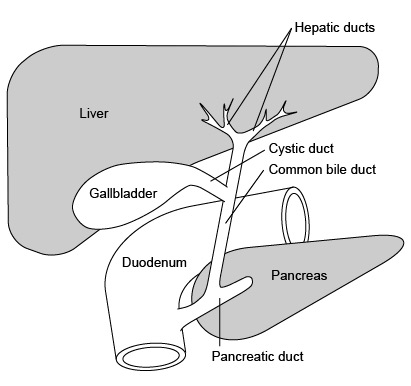小结
定义
病史和体格检查
关键诊断因素
- previous episode of biliary pain
- right upper quadrant pain
- positive Murphy sign
- abdominal mass
其他诊断因素
- right shoulder pain
- anorexia
- nausea
- fever
- vomiting
- jaundice
危险因素
- gallstones
- physical inactivity
- low fiber intake
- severe illness
- trauma
- severe burns
- total parenteral nutrition (TPN)
- diabetes
- use of ceftriaxone
- use of cyclosporine
- hepatic arterial embolization
- infections
诊断性检查
首要检查
- CBC
- C-reactive protein
- LFTs
- right upper quadrant ultrasound scan
需考虑的检查
- cholescintigraphy (hepatobiliary iminodiacetic acid [HIDA] scan)
- abdominal CT
- abdominal MRI
- abdominal x-ray
治疗流程
mild (grade I): stable without signs of perforation/gangrene
moderate (grade II): stable with signs of perforation/gangrene
severe (grade III): suspected gangrene/perforation or evidence of organ dysfunction
撰稿人
专家顾问
Charles Bellows, MD
Professor of Surgery
University of New Mexico
School of Medicine
Albuquerque
NM
利益声明
CB is an author of one study referenced in this topic. CB declares that he has no other competing interests.
同行评议者
Satyajit Bhattacharya, LVO, MB, MS, MPhil, FRCS
Consultant Surgeon
HPB Surgery Unit
The Royal London Hospital
London
UK
利益声明
SB declares that he has no competing interests.
Stefano Guandalini, MD
Professor of Pediatrics
Chief
Division of Gastroenterology, Hepatology, and Nutrition
University of Chicago Comer Children's Hospital
Chicago
IL
利益声明
SG declares that he has no competing interests.
Peer reviewer acknowledgements
BMJ Best Practice topics are updated on a rolling basis in line with developments in evidence and guidance. The peer reviewers listed here have reviewed the content at least once during the history of the topic.
Disclosures
Peer reviewer affiliations and disclosures pertain to the time of the review.
参考文献
关键文献
Yokoe M, Hata J, Takada T, et al. Tokyo Guidelines 2018: diagnostic criteria and severity grading of acute cholecystitis (with videos). J Hepatobiliary Pancreat Sci. 2018 Jan;25(1):41-54.全文 摘要
Pisano M, Allievi N, Gurusamy K, et al. 2020 World Society of Emergency Surgery updated guidelines for the diagnosis and treatment of acute calculus cholecystitis. World J Emerg Surg. 2020 Nov 5;15(1):61.全文 摘要
Gomi H, Solomkin JS, Schlossberg D, et al. Tokyo Guidelines 2018: antimicrobial therapy for acute cholangitis and cholecystitis. J Hepatobiliary Pancreat Sci. 2018 Jan;25(1):3-16.全文 摘要
Mayumi T, Okamoto K, Takada T, et al. Tokyo Guidelines 2018: management bundles for acute cholangitis and cholecystitis. J Hepatobiliary Pancreat Sci. 2018 Jan;25(1):96-100.全文 摘要
Wakabayashi G, Iwashita Y, Hibi T, et al. Tokyo Guidelines 2018: surgical management of acute cholecystitis: safe steps in laparoscopic cholecystectomy for acute cholecystitis (with videos). J Hepatobiliary Pancreat Sci. 2018 Jan;25(1):73-86.全文 摘要
参考文献
A full list of sources referenced in this topic is available to users with access to all of BMJ Best Practice.

鉴别诊断
- Acute cholangitis
- Chronic cholecystitis
- Peptic ulcer disease
更多 鉴别诊断指南
- ACR appropriateness criteria: right upper quadrant pain
- TG18 flowchart for the management of acute cholecystitis
更多 指南Videos
Venepuncture and phlebotomy: animated demonstration
Central venous catheter insertion: animated demonstration
更多 操作视频患者教育信息
Gallstones
更多 患者教育信息登录或订阅即可浏览 BMJ Best Practice 临床实践完整内容
内容使用需遵循免责声明
